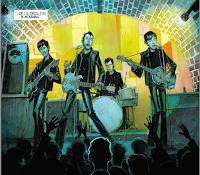WEEK NINE
Papyrus:
Imhotep’s Transformation, by De Gieter was good to read because it was well
drawn and descriptive, it captured Ancient Egyptian culture, and it was a
decent narrative story.
The text bubble on the first page of the comic
explained the specific setting of Ancient Egypt. It was informative about the
Nile Delta and how it formed the land of Ancient Egypt. I liked the image of
the Delta with a dead tree and marsh water as the foreground, along with a bird
flying in the sky and tall trees sticking out of the swampy land, and the clear
blue desert sky as the background. There is a good amount of depth in this one
frame.


What I found to be culturally
interesting were the frames of the Egyptian slave laborers pulling the statue
of the pharaoh with ropes, their bare hands, and the rest of their bodies. I
can imagine how difficult it was; these frames gave me a sense of the intensity,
challenge, and struggle it must have been to build pyramids in Ancient Egypt
times.

For me personally, the story itself
was pretty basic. I saw it as a typical hero’s journey story, set up by narrative
features like a plot by an antagonist to kill the king, the trick of having
blood pouring out of the statue’s nose in order to scare off the slave labors
as a distraction to kill the pharaoh, the poisoning of the pharaoh, and the
need to find a cure. Imhotep and Papyrus then go on a mission to find an herb
that will save Pharaoh, which turns out to be a crocodile herb. It is common in
a hero’s story to have the hero search for a magical cure. These conflicts and
actions have been seen throughout the course in other narrative stories, but
this one was still entertaining to me. I also liked the fact that the comic has
a happy ending, in which there are two pharaohs at the end.
In
conclusion, I chose this story mainly because I learned a lot about Ancient
Egyptian art and culture in Development of Arts and Ideas, which I took in my sophomore
year. This made me more interested in reading a comic about this time
period.

Comments
Post a Comment